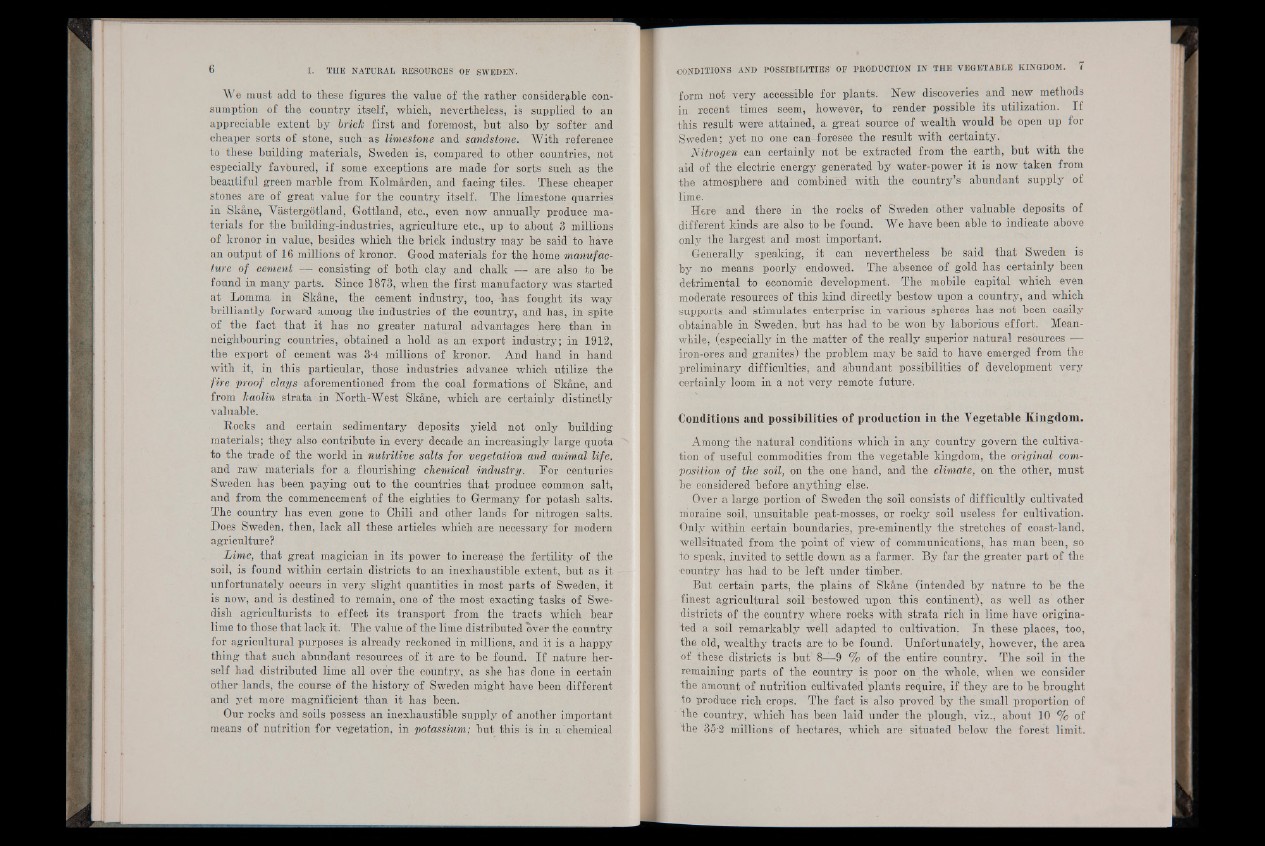
We must add to these figures the value of the rather considerable consumption
of the country itself, which, nevertheless, is supplied to an
appreciable extent by brick first and foremost, but also by softer and
cheaper sorts of stone, such as limestone and sandstone. With reference
to these building materials, Sweden is, compared to other countries, not
especially favbured, if some exceptions are made for sorts such as the
beautiful green marble from Kolmarden, and facing tiles. These cheaper
stones are of great value for the country itself. The limestone quarries
in Skane, Vastergotland, Gottland, etc., even now annually produce materials
for the building-industries, agriculture etc., up to about 3 millions
of kronor in value, besides which the brick industry may be said to have
an output of 16 millions of kronor. Good materials for the home manufacture
of cement —- consisting of both clay and chalk — are also to be
found in many parts. Since 1873, when the first manufactory was started
at Lomma in Skane, the cement industry, too, -has fought its way
brilliantly forward among the industries of the country, and has, in spite
of the fact that it has no greater natural advantages here than in
neighbouring countries, obtained a hold as an export industry; in 1912,
the export of cement was 3-4 millions of kronor. And hand in hand
with it, in this particular, those industries advance which utilize the
fire proof clays aforementioned from the coal formations of Skane, and
from kaolin strata in North-West Skane, which are certainly distinctly
valuable.
Rocks and certain sedimentary deposits yield not only building
materials; they also contribute in -every decade an increasingly large quota
to the trade of the world in nutritive salts for vegetation and animal life.
and raw materials for a flourishing chemical industry. For Centuries
Sweden has been paying out to the countries that produce common salt,
and from the commencement of the eighties to Germany for potash salts.
The country has even gone to Chili and other lands for nitrogen salts.
Does Sweden, then, lack all these articles which are necessary for modern
agriculture?
Lime, that great magician in its power to increase the fertility of the
soil, is found within certain districts to an inexhaustible extent, but as it
unfortunately occurs in very slight quantities in most parts of Sweden, it
is now, and is destined to remain, one of the most exacting tasks of Swedish
agriculturists to effect its transport from the tracts which bear
lime to those that lack it. The value of the lime distributed over the country
for agricultural purposes is already reckoned in millions, and it is a happy
thing that such abundant resources of it are to be found. I f nature herself
had distributed lime all over the country, as she has done in certain
other lands, the course of the history of Sweden might have been different
and yet more magnificient than it has been.
Our rocks and soils possess an inexhaustible supply of another important
means of nutrition for vegetation, in potassium; but this is in a chemical
form not very accessible for plants. New discoveries and new methods
in recent times seem, however, to render possible its utilization. I f
this result were attained, a great source of wealth would be open up for
Sweden; yet no one can foresee the result with certainty.
Nitrogen can certainly not be extracted from the earth, but with the
aid of the electric energy generated by water-power it is now taken from
the atmosphere and combined with the country’s abundant supply of
lime.
Here and there in the rocks of Sweden other valuable deposits of
different kinds are also to be found. We have been able to indicate above
only the largest and most important.
Generally speaking, it can nevertheless be said that Sweden is
by no means poorly endowed. The absence of gold has certainly been
detrimental to economic development. The mobile capital which even
moderate resources of this kind directly bestow upon a country, and which
supports and stimulates enterprise in various spheres has not been easily
obtainable in Sweden, but has had to be won by laborious effort. Meanwhile,
(especially in the matter of the really superior natural resources —
iron-ores and granites) the problem may be said to have emerged from the
preliminary difficulties, and abundant possibilities of development very
certainly loom in a not very remote future.
Conditions and possibilities of production in the Yegetable Kingdom.
Among the natural conditions which in any country govern the cultivation
of useful commodities from thé vegetable kingdom, the original composition
of the soil, on the one hand, and the climate, on the other, must
be considered before anything else.
Over a large portion of Sweden the soil consists of difficultly cultivated
moraine soil, unsuitable peat-mosses, or rocky soil useless for cultivation.
Only within certain boundaries, pre-eminently the stretches of coast-land,
wellsituated from the point of view of communications, has man been, so
to speak, invited to settle down as a farmer. By far the greater part of the
country has had to be left under timber.
But certain parts, the plains of Skâne (intended by nature to be the
finest agricultural soil • bestowed upon this continent), as well as other
districts of the country where rocks with strata rich in lime have originated
a soil remarkably well adapted to cultivation. In these places, too,
the old, wealthy tracts are to be found. Unfortunately, however, the area
of these districts is but 8—9 % of the entire country. The soil in the
remaining parts of the country is poor on the whole, when we consider
the amount of nutrition cultivated plants require, if they are to be brought
to produce rich crops. The fact is also proved by the small proportion of
the country, which has been laid under the plough, viz., about 10 % of
the 35-2 millions of hectares, which are situated below the forest limit.